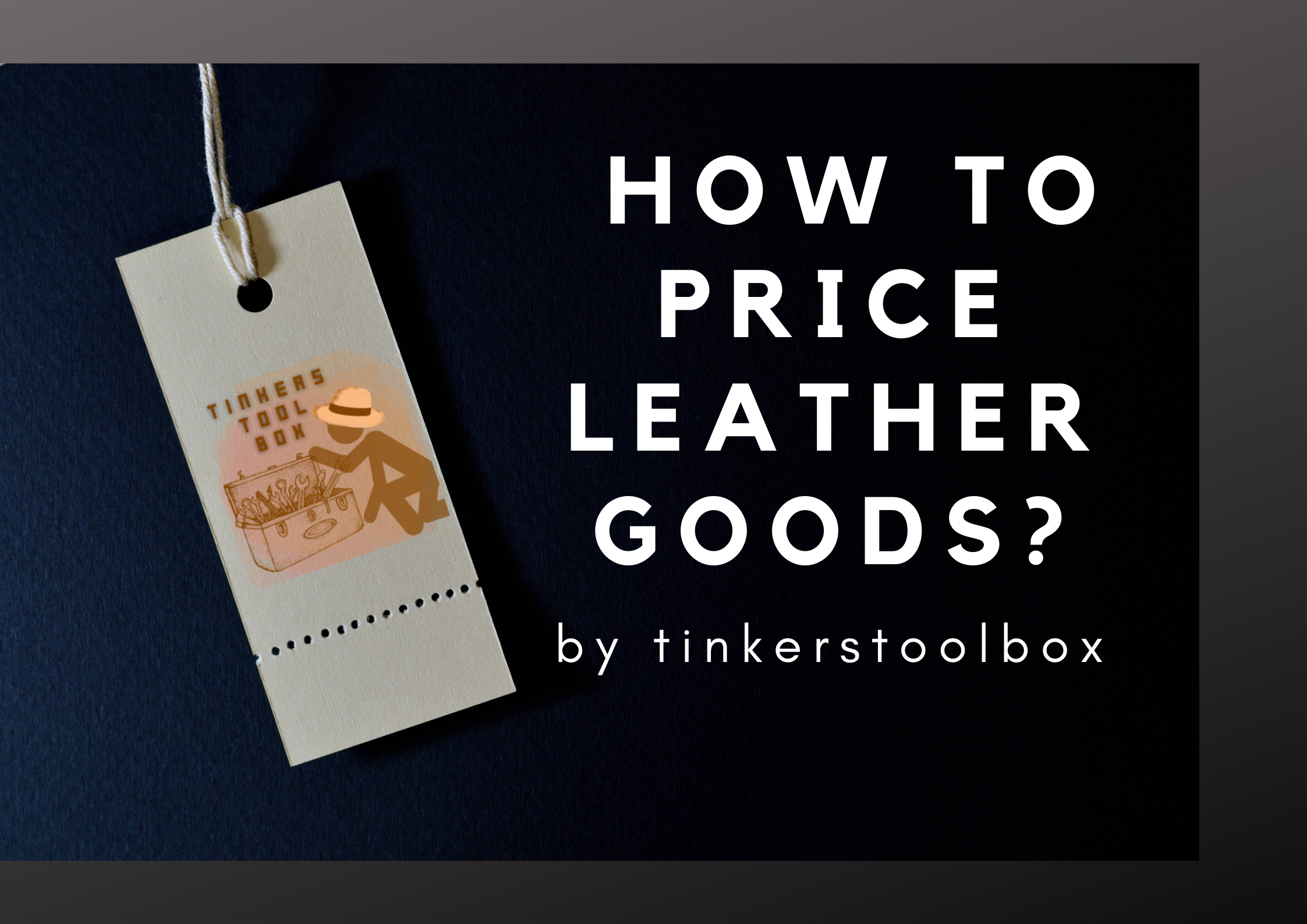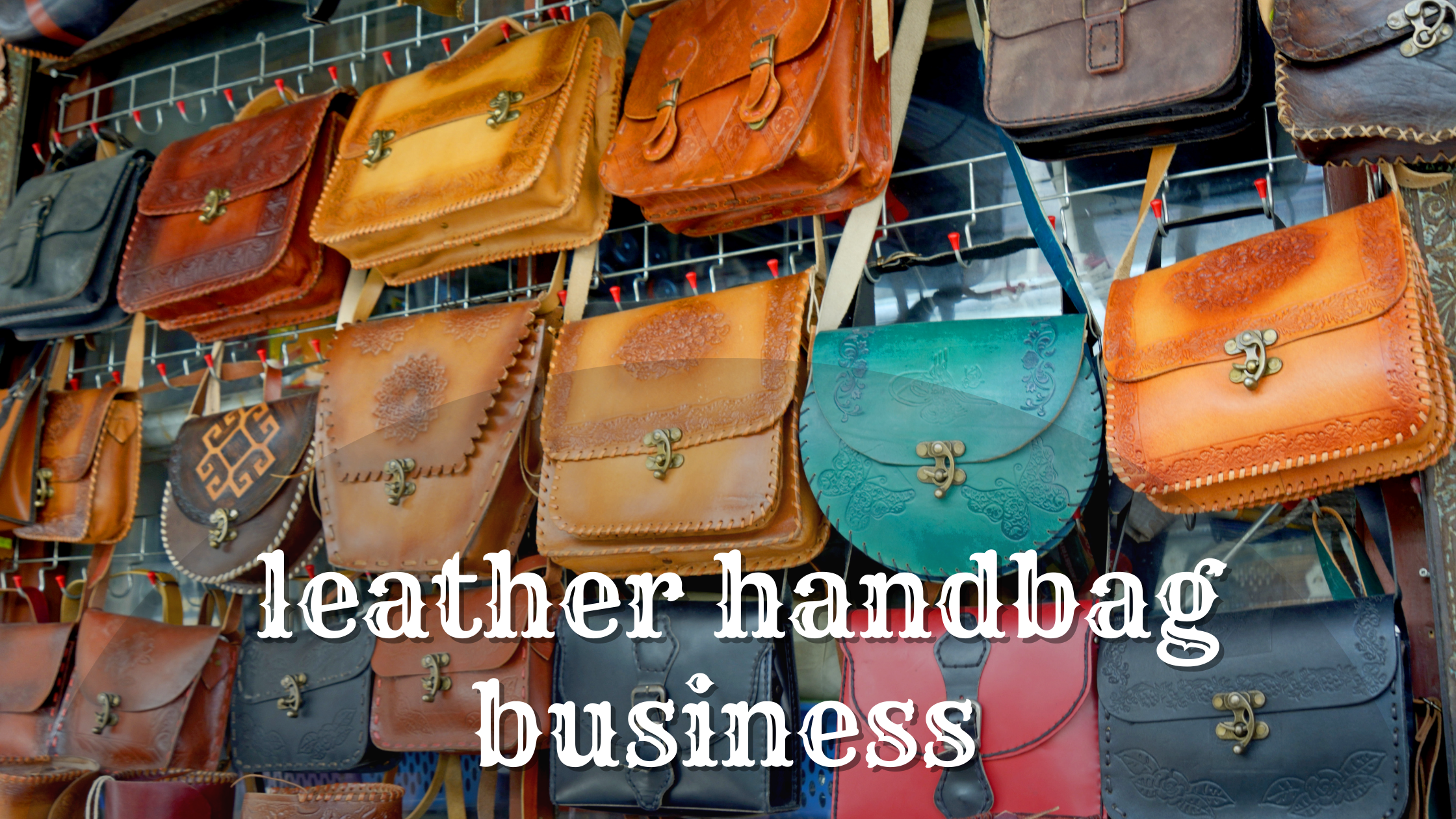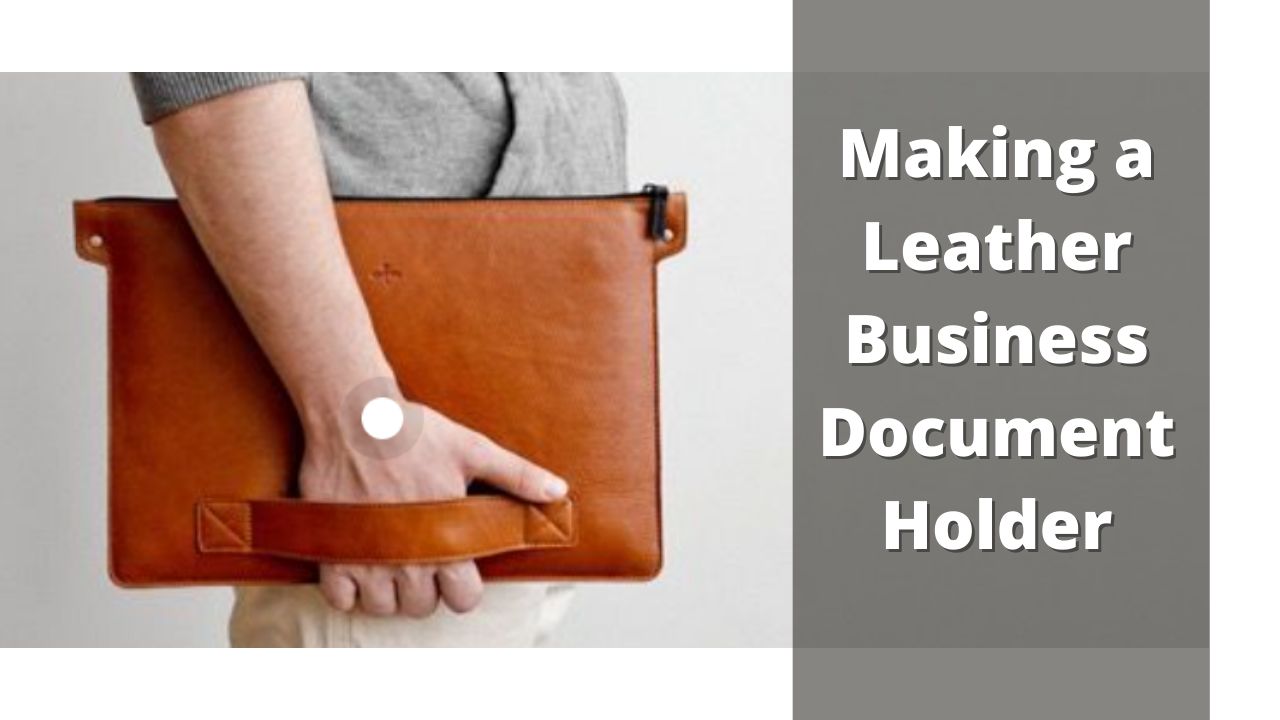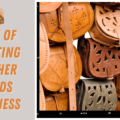Pricing your product is one of the most confusing things to do. Many leather workers and crafters said that pricing is one of the toughest decisions they have to make. Harder than choosing a course to take in college. And this is where they get lost sometimes. Some of the things you will need to consider when pricing your product is your cash flow and profit margins, and if you don’t know about these, then probably you’ll get stuck in the first stage of starting a business. That can also be the reason why you will stop launching. But worry no more because I will be more than happy to show you how to price your leather works so that nothing can stop you from launching the business you always dreamed of.
Price your leather goods to consider making up for the capital you lost in making the product and cover the target revenue you set to make. Make a list of all your expenses from tangible costs and intangible costs to make up your capital. From your capital, add a reasonable amount to account for your labor and time and most especially to consider your income.
True enough, pricing can be more stressful than making the craft itself. However, if you have something that will guide you, it will make everything a lot easier than figuring things out all by yourself. That is the reason why I’d come with this article. In this, we will not just be talking about how to price your leather works but many things such as making sure you’ll get the sales you wanted. Carry on and learn!
Things To Consider When Pricing Your Leather Goods
Before diving into anything else, you should first know how to price your leather goods. And pricing is not that complicated as it seems only if you know where to start. So without further ado, let me get you familiar with leather goods pricing 101.
The Cost of All Your Expenses
After all the cuttings and stampings, it is now time for you to price your leather goods. But how? The first tip that I can give you is knowing all the costs of your expenses, including your time and effort. To make this step easier, you can list all your expenses per project or the tangible expenses. Let’s say your tangible expenses cost $83.73 per project. This includes the cost of leather per sq ft., all your materials like dyes, leather conditioner, needle and thread, rivets, buttons, etc. From there, you can now add your intangible expenses, which are your labor and time.
After computing it all, it is now time for you to finally know all the things where you’ve spent and will spend your money. The sampling formula is Tangible costs (materials per project) + Intangible costs (labor and time) +Shipping (depends on your courier) and other outside fees (sometimes sellers add the gas they have consumed and delivery fees they spent when they buy a certain material) =Capital. And after you’ve filled up those, you are now going to solve your income or profit. Add a reasonable amount to your capital, and you’ll finally know what your profit will be. And the formula for this is Capital+Reasonable Amount=Income or Profit.
A reasonable amount is an amount that you will add up after counting all your expenses. In this one, as a seller, you will be the one who’s going to decide how much that would be. In other words, that amount is something that you thought will not be a heavy burden for your customers. And that will also serve as a reward for your hard work.
For example, all your expenses cost $25, and for the reasonable amount, you’ve added a fair amount of $5. That means you can earn an instant $5 per project aside from your intangible expenses.
Remember, when pricing your leather goods, you should also consider the type and quality of the products you’ve used. If you used a full grain or other authentic leather and partnered it with a high-quality leather conditioner and dye, most probably you can sell your leather goods higher than the expected amount. And that is because your customers will surely find that your leather goods are worth their money. Also, consider the uniqueness of your product, for that is another factor to gain your worth in the leather goods selling industry.
The Time You Spent Making Leather Goods
We’ve discussed above that time is an intangible expense together with the labor. And if you will ask why it is included, that is because time is money. Like a regular employee working in a company, you should also track your time making a masterpiece. It is better to note the hours you spent making one craft, and if it took you long, that means your efforts should be paid off. It would also be helpful to keep track of them from the first day of working until the day you finish the project.
Figure Out Your Target Market
Image: Lion Share
This is probably one of the most important things to know to price your leather goods properly and accordingly. By knowing who and what your market will be, you’ll be able to weigh things out to be more considerable and fit into what your customer needs.
When we talk about the market, it is not just where you will put up a business. It is also about the people to whom you will sell your products to. For example, survey the features they wanted in a tote bag if you chose to target moms you think will need a tote bag whenever they go shopping. Do they want it with an extra pocket on the outside? Do they want it plain? Or do they want it to be customized? You can ask your friends personally or, to be safer, especially at this time, do a survey which you can do online and send it to them if they agree to participate.
Yet, if you want a bigger market, then make it general. Know what the trend is in all ages, sizes, and gender, so you will know if the price you come up with is affordable in a certain group.
Know Your Competition
In all types of business, you will surely have competitors who sell the same product as you. And that is very common even in the world of designer brands. In this industry, you should be in line with what your competitors are up to.
It would be better if you study the strategy and techniques of your competitors first. For example, if you chose to put your leather goods business in a bazaar, for sure there will be a stall that has the same products as yours. So just observe if your competitors already have the product that is in your mind. And if they do, think of something that will still attract customers.Maybe add some twist on the products or promos.
Moreover, look at your competitor’s product prices and develop a plan to match their price or compare it to yours. Either you will put a price the same as theirs or be between cheap and expensive because you know your product has a higher quality than theirs.
Lastly, take the time to research your competitor’s profile or see if they have blogs and social media pages where they promote their products. And if you see that they are gaining their market, start doing your part and promote your product on your own blog and page because that for sure can also help you and your business grow.
Set A Revenue Target
Image: MBA SKOOL
The last tip I want to give you on our leather goods pricing 101 is setting a revenue target. It may sound a bit complex, but I am telling you this will teach you how to strive more.
In revenue target, we’re talking about the price in the long run or your whole company’s profit. It will be more helpful specifically once your leather goods business is at its peak of success.
When setting a target revenue, count or list all your expenses, including the fees earned like customer’s tip, income revenue, number of sold products, number of produced products. Since you are looking at the bigger picture here, set an aim and estimate the number of products that you can make in a year. For our sample formula, it goes like if you are aiming to sell 1000 leather wallets in the next year and your price per piece is $40, compute it like this:
1000(product’s quantity aim) x $40 (the price per piece)= $40,000
That means the whopping $40,000 is the clean amount that you will get once those 1000 leather wallets are in the hands of your customers.
Pricing Guide For Your Handmade Leather Goods (Estimated Expenses)
After the tip section, let’s now talk about the ideal amount that you can get per leather goods. I have here the estimated expenses that you can use as a guide when doing a project. And this is also where we will use the tips above.
Make Your Own Designer Tote Bag
One of the most popular leather goods in the leather world is bag making. If you use a full-grain leather for your tote bag, you will consume a six sq ft of leather with 3 to 4 ounces thickness which will cost $36.72. After that, you will have to add a leather conditioner for it to have a beautiful finish.
Aside from those, you will also be needing nylon or waxed thread for stitching which is about $7, and metal snaps for the locks that cost $9. That will give you a total amount of $72.71. From your tangible expenses, now add the intangible ones who are your labor fee, time, and reasonable amount. Let’s say for your labor and time, you’ve decided to price them $50, and for the reasonable amount, you put an additional $10. Your total now will be $132.71.
The selling price of leather tote bags in the market is $200-$300 per piece. If you sell it for $200, you will have a profit of $67.29 per piece. Not bad, right?
Easy DIY Leather Shoes For Beginners
Let’s make this one simple for beginners in leather crafting. Let’s say after your successful tote bags, you’ve added another product which is leather shoes. For this one your materials will be a fabric leather (for exterior and interior) 2 yards that you can get for $50. Next to it is a shoelace for $4, a shoe glue for $10, a leather shoes and half soles for $ 2.98 and a leather needle and thread for $5 to have a total of $71.98
Image: Amazon
If you check Amazon for the leather shoe prices, you’ll see cheaper items than yours. That’s why knowing your competitor is essential. You’re now over their price by providing the total of your tangible expenses, which is $71.98. But don’t get upset about it. Instead, make a strategy of how you can compete with your competitors’ prices.
If the market has $100 or below the selling price, combine the labor cost and reasonable amount to have a fair price. So, if your intangible cost is $5.7, your overall total will be $77.68. If you choose to sell it for $100, you will have a profit of $22.32, or you can sell them for $90, so you are in between your competitor’s price and your ideal price.
Estimated Cost For A Leather Wallet
Another leather goods that are very common in the leather project industry is wallet making. Usually, for a simple wallet, a leatherworker only needs one sq ft vegetable-tanned leather, which is about $7.25.After doing the stitching and all, it is time to finish your beautiful leather wallet with jojoba oil that costs $9.99.
For the intangible expenses, let’s assume that your labor and the reasonable amount is $7. That will give you a total of $24.24 as your capital. In today’s market, you can sell a leather wallet for $30-$40, so you can get a profit of $ 5.76 if the selling price is $30 and $15.76 if the selling price is $40.
As you grow your business, your expenses will probably be cheaper since you are not starting from zero anymore because you already have a set of materials beforehand. That means, when that time comes, you will surely earn more by selling more.
Leather Project For Someone Who Loves Traveling
Image: Amazon
In this pandemic, people surely miss the time when they can travel in a snap without getting travel passes, which causes hassle. So for a leather project that they surely need, a fashionable leather passport holder would be perfect.
The only material you need to buy is about 1sq ft. of vegetable-tanned leather which will cost $7.25. Because your business is quite big at this point, let’s still keep it lowkey and decide to give labor a fair amount of $10 for an hour or so of work. And for the reasonable amount, let’s add another $10, which will be $27.25 in total.
In the market, a passport holder usually ranges from $9 to $15. If this happens, where your capital is bigger than the selling price, the seller can achieve this by selling ten pieces or more (think of the revenue target).
Lavish Leather Belt
Image: Amazon
Now here comes another leather goods that will bring more sales to your business. This time, let’s make it easier for you. You don’t have to do all the measuring and cutting to start this project. There is a premade leather belt with snaps and holes that costs $23.04 that you can get it on Tandy Leather.
The other materials are the buckle and loop that you can get for $9, a leather conditioner for $9.22, and leather oil for $9.99 (optional). Although you bought a premade leather belt, let’s still put $7 as your labor and a reasonable amount. That will give you a total of $39.04.
Since your business is at its peak now, let’s apply setting a target revenue for motivation and bigger sales. Remember to always look at the bigger picture. Make a target revenue by computing the number of products you are aiming for. For example, you are targeting to sell 1000 leather belts in the next year, and you will put it at the price of $50 for it is a mid-quality belt. The formula will be:
1000 (products/quantity)*$50 (price per piece)= $50,000
So $50,000 would be the amount of your revenue target. By that being said, you can now choose to price your leather belts cheaper, if you find $50,000 enough for your whole year of hard work or expensive because you think you deserve more than $50,000
Formula To Have More Sales!
Great! Now that you’ve come to the last part, you’ll now know the bonus topic I prepared for you. After pricing your products, the next thing that you will have to do is to ensure that they will be known. And a more popular brand means more sales! There are only two formulas that you have to remember if you want to have more sales. The first formula is to make sure that your leather goods will stand out and second is about solving your customer’s problems. So let’s go dig into it to better understand these two.
Make Your Leather Goods Shine!
Over time, there are fancy trends that pass in every generation. But now, observe that people prefer things that are uniquely crafted. There is also this theme that they call ‘aesthetic’ , where sometimes you can spot a leather accessory or a leather garment being the star of the whole outfit.
To have more sales, make sure that your items will stand out among the other leather crafts out there. After knowing what those are, make unique yet simple products that will surely stand out! But, always make an original design and not just grab or copy the other crafter’s idea. Be creative! Make time to do your research about the trend in every generation.
Solve Your Customer’s Problem
Image Source: Hyken
It is not always what the customers want; it is now what they need in their everyday lives. When starting a leather goods business, always consider your customers’ needs because that’s how you’re going to keep customers buying your product.
If people find your products helpful, of course with a bit of a fashion, aside from buying endlessly, they can also recommend you to their friends. So make sure it’s the product they are looking for. But how? Start asking your friends about it. Get their opinions, and the tally is based on the most answers. Because when you are starting, the people around you are always your first market.















